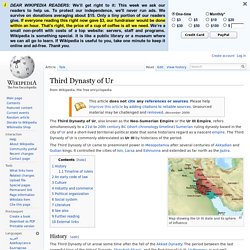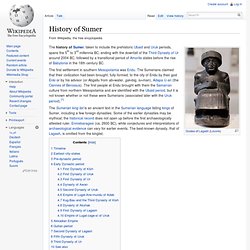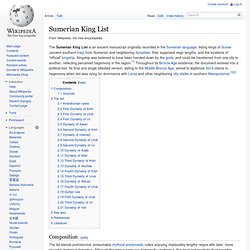

Third Dynasty of Ur. The Third Dynasty of Ur, also known as the Neo-Sumerian Empire or the Ur III Empire, refers simultaneously to a 21st to 20th century BC (short chronology timeline) Sumerian ruling dynasty based in the city of Ur and a short-lived territorial-political state that some historians regard as a nascent empire.

The Third Dynasty of Ur is commonly abbreviated as Ur III by historians of the period. The Third Dynasty of Ur came to preeminent power in Mesopotamia after several centuries of Akkadian and Gutian kings. It controlled the cities of Isin, Larsa and Eshnunna and extended as far north as the Jazira. Map showing the Ur III state and its sphere of influence History[edit] The Third Dynasty of Ur arose some time after the fall of the Akkad Dynasty.
Following Utu-Hengal's reign, Ur-Nammu (originally a general) founded the dynasty of Ur-III, but the precise events surrounding his rise are unclear. It is possible that Ur-Nammu was originally his governor. Timeline of rulers[edit] Middle chronology. History of Sumer. The history of Sumer, taken to include the prehistoric Ubaid and Uruk periods, spans the 5th to 3rd millennia BC, ending with the downfall of the Third Dynasty of Ur around 2004 BC, followed by a transitional period of Amorite states before the rise of Babylonia in the 18th century BC.

The first settlement in southern Mesopotamia was Eridu. The Sumerians claimed that their civilization had been brought, fully formed, to the city of Eridu by their god Enki or by his advisor (or Abgallu from ab=water, gal=big, lu=man), Adapa U-an (the Oannes of Berossus). The first people at Eridu brought with them the Samarran culture from northern Mesopotamia and are identified with the Ubaid period, but it is not known whether or not these were Sumerians (associated later with the Uruk period).[1] The Sumerian king list is an ancient text in the Sumerian language listing kings of Sumer, including a few foreign dynasties. Timeline[edit] Dates are approximate, consult particular article for details.
Sumerian King List. The Sumerian King List is an ancient manuscript originally recorded in the Sumerian language, listing kings of Sumer (ancient southern Iraq) from Sumerian and neighboring dynasties, their supposed reign lengths, and the locations of "official" kingship.

Kingship was believed to have been handed down by the gods, and could be transferred from one city to another, reflecting perceived hegemony in the region.[1] Throughout its Bronze Age existence, the document evolved into a political tool. Its final and single attested version, dating to the Middle Bronze Age, aimed to legitimize Isin's claims to hegemony when Isin was vying for dominance with Larsa and other neighboring city-states in southern Mesopotamia.[1][2] Composition[edit] Sources[edit] The following extant ancient sources contain the Sumerian King List, or fragments: The first two sources (WB) are a part of the "Weld-Blundell collection", donated by Herbert Weld Blundell to the Ashmolean Museum. Translation of the Sumerian Cuneiform - KHARSAG - HEAD ENCLOSURE - Barton 1914 - Hilprecht - Poebel - Babylonian Text.
Translation of the Sumerian CuneiformExtract from The Genius of the Few by Christian and Barbara Joy O'Brien - Page 37 - 39 The Anannage, therefore, were the Sumerian equivalents of the biblical Angels.

Only after they had disappeared from the Middle Eastern scene were they worshipped in the religious sense; and they were then so enveloped in supernatural trappings that their intrinsic characteristics were swamped in a morass of pseudo-religious adulation. Sumerian Myths. Sumerian civilization originated in what is now southern Iraq, just upriver from the mouths of the Tigris and Euphrates rivers.

"Civilization" in this context means a settled town or city-dwelling people who possess a stable agricultural technology (including domesticated animals) and have developed a hierarchical system of social classes (peasants, laborers, slaves, craftsmen [smiths, masons, carpenters, potters, etc.], farmers, fishermen, merchants, doctors, architects, priests and temple attendants, bureaucrats, scribes, advisers, priest-kings). Since the climate of southern Iraq is hot and dry, agriculture requires an extensive irrigation system of canals and dikes. Often, the Sumerians wrote as if their civilization (agricultural techniques, cities, classes of people) came first, and people later. (Why do you think they thought this way?) Map of Mesopotamian Archeological Sites (Oriental Institute, University of Chicago)
The Sumerian King List: Antediluvian Kings. The Great Flood - Sumerian Version. The Epic of gilgamesh. Epic of Gilgamesh. Sumerian Gods.